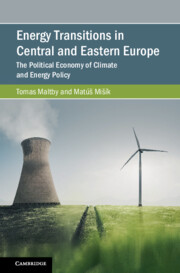Book contents
- Energy Transitions in Central and Eastern Europe
- Cambridge Studies on Environment, Energy and Natural Resources Governance
- Energy Transitions in Central and Eastern Europe
- Copyright page
- Dedication
- Contents
- Figures
- Tables
- Preface
- Acknowledgements
- Abbreviations
- Introduction
- 1 The Development of Energy and Climate Policy in the EU and CEE
- 2 A Conceptual Framework for Understanding Energy Transitions
- 3 Energy Governance
- 4 The Effect of Foreign Policy on Climate and Energy Policy
- 5 State-Society Relations
- 6 The Influence of CEE Countries on EU Climate and Energy Policy
- 7 The Global Context
- 8 Conclusion
- Bibliography
- Index
2 - A Conceptual Framework for Understanding Energy Transitions
Published online by Cambridge University Press: 19 April 2024
- Energy Transitions in Central and Eastern Europe
- Cambridge Studies on Environment, Energy and Natural Resources Governance
- Energy Transitions in Central and Eastern Europe
- Copyright page
- Dedication
- Contents
- Figures
- Tables
- Preface
- Acknowledgements
- Abbreviations
- Introduction
- 1 The Development of Energy and Climate Policy in the EU and CEE
- 2 A Conceptual Framework for Understanding Energy Transitions
- 3 Energy Governance
- 4 The Effect of Foreign Policy on Climate and Energy Policy
- 5 State-Society Relations
- 6 The Influence of CEE Countries on EU Climate and Energy Policy
- 7 The Global Context
- 8 Conclusion
- Bibliography
- Index
Summary
This chapter presents the conceptual framework of the book that builds upon several strands of literature: socio-technical systems, institutional and political change, and securitisation. Drawn from existing literature the authors argue that several key factors account for national climate and energy policies, and explain the extent of the region’s climate and energy policy homogeneity and heterogeneity. Such an approach enables the book to identify the differences between individual CEE countries – for instance, the role of ideas can be used to describe the different understandings of what constitutes energy security issues, and the solutions to these. Some but certainly not all countries in the region securitise this issue (e.g., Lithuania and Poland) and frame energy security as a national security challenge, highlighting the foreign policy implications of climate and energy policy and influencing both domestic and EU policy choices.
Keywords
- Type
- Chapter
- Information
- Energy Transitions in Central and Eastern EuropeThe Political Economy of Climate and Energy Policy, pp. 36 - 48Publisher: Cambridge University PressPrint publication year: 2024

